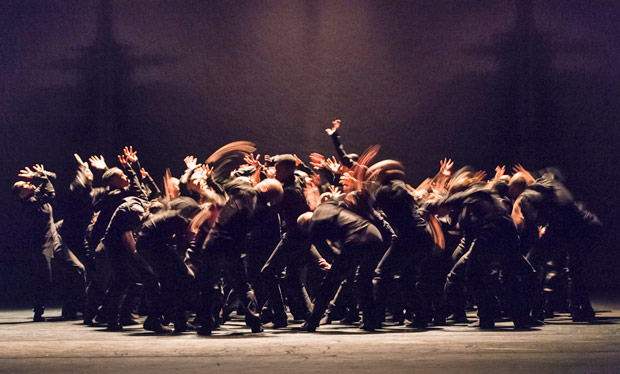
© Foteini Christofilopoulou. (Click image for larger version)
Thomas Adès, See the Music, Hear the Dance
Karole Armitage: Life Story
Wayne McGregor: Outlier
Crystal Pite: Polaris
Alexander Whitley: The Grit in the Oyster
London, Sadler’s Wells
31 October 2014
Gallery of pictures by Foteini Christofilopoulou
More details at: www.sadlerswells.com
Sadler’s Wells indicate that their showcase of dance to the music of Thomas Adès is one of an intended series centred on composers. If they can muster comparable musical and choreographic forces in future, that should certainly be something to look forward to. This programme featured Adès himself as conductor and pianist, leading the forces of the Britten Sinfonia.
The Britten Sinfonia played for the Richard Alston Dance Company at the Barbican last season and proved one of the musical highlights of that year. It’s not often we get such high quality performances of live music for contemporary dance. Here their playing was wonderfully focused and alive, impressive in a range of work from the intimate to the epic.

© Foteini Christofilopoulou. (Click image for larger version)
The programme featured four works from different dance makers, two existing and two specially commissioned for this occasion. Wayne McGregor originally made Outlier for New York City Ballet in 2010. Here it is performed by members of his own company, Random Dance. Adès conducts the performance of his violin concerto, Concentric Paths.
If you are already familiar with McGregor’s work then there will be no surprises here. The nine dancers pursue his energetic, twitchy vocabulary and splay their limbs and rocket their legs upward with great commitment. In its original form for a ballet company, this work would most likely have been on pointe. It isn’t here, but it doesn’t seem that it’s that which accounts for the lack of overall impact. The relationship with the music is seldom apparent. Convulsions take place in the orchestra while nothing much happens on stage. Other works on the bill achieved a much closer integration with the music. Other elements in the collaboration worked well, with some interesting stripes of lighting from Lucy Carter. The violin soloist was Thomas Gould, much appreciated by the audience at the curtain.

© Foteini Christofilopoulou. (Click image for larger version)
The central part of the programme, featuring two short pieces, moved us into a much more intimate, private world. Karole Armitage’s Life Story from 1999 is the oldest work in the programme, here performed by two members of her own company. Adès is on stage at the piano with the feisty soprano, Claire Booth, leaning amorously against it. She sings words by Tennessee Williams about a dysfunctional relationship that we see enacted in the bodies of the dancers. The problem with this (if you can say it is a problem) is that the singer is so charismatic and has so much stage presence that it’s difficult to tear your gaze away from her and from her interactions with Adès who projects a remarkable liveliness and vitality from the keyboard. The dance does sit well on the music and embodies the difficulties and uncertainties between man and woman. But my gaze kept shifting back to the piano. It’s a short piece but it builds an entire world in its brief span.

© Foteini Christofilopoulou. (Click image for larger version)
Alexander Whitley’s The Grit in the Oyster is a new commission, to Adès’s Piano Quintet. The musicians are positioned towards the back and side of the stage, clustered round Adès at the piano. The work is for three dancers, Whitley himself and two women. There is a quiet, secretive air to all this, as if the performance was intended for private consumption: it draws you in and makes you want to lean forward so as not to miss a single note. This work seemed to have climbed successfully inside the music, with one of the women in particular here reflecting it in a fine solo. Perhaps the main stage at Sadler’s is a little too big for this work; you want to be closer to musicians and dancers.

© Foteini Christofilopoulou. (Click image for larger version)
The big hit of the evening though is undoubtedly the final piece, Crystal Pite’s take on Adès mighty Polaris. It’s a very unusual opportunity for this special programme and Pite has grabbed it with both hands. Polaris is a huge piece of music and Pite has gone for a suitably epic response. Students from the London Contemporary Dance School and Central School of Ballet join six dancers from Pite’s Kidd Pivot company to swell the numbers on stage to 64.
It’s very rare in contemporary dance to have such resources engaged, and especially so to live music. When the massed ranks storm across the stage to the hurricane force produced by the Britten Sinfonia in the pit, it’s a real jolt of adrenaline. The dancers form great waves and mounds, handled by Pite with extreme dexterity. They appear at times like an entire unified rippling organism rather than individuals. It’s a dark piece, costumed in odd, rustling black overalls, with very effective lighting from Tom Visser, often showing the dancers in silhouette. In quieter passages Pite’s own dancers get some chances to shine individually.

© Foteini Christofilopoulou. (Click image for larger version)
One viewing (and hearing) of this piece just isn’t enough to get to grips with it properly. There have been only three chances to see it as part of this mixed bill. Though the logistics are challenging, it would be great to see it revived in the future. Adès looked a very happy man at the curtain calls as if ready to hug the entire cast.

















You must be logged in to post a comment.